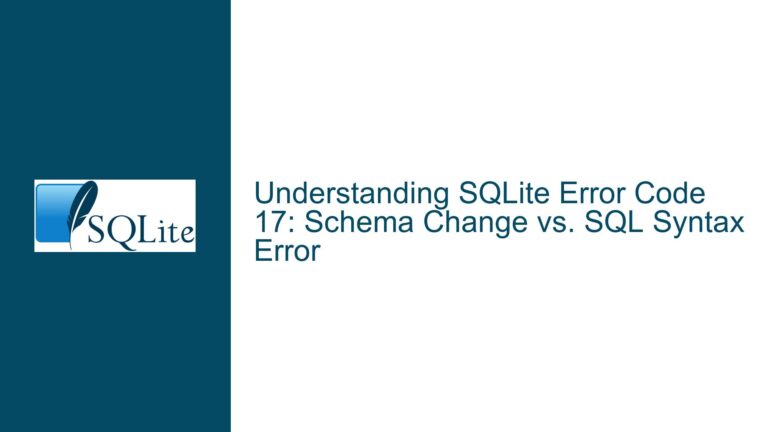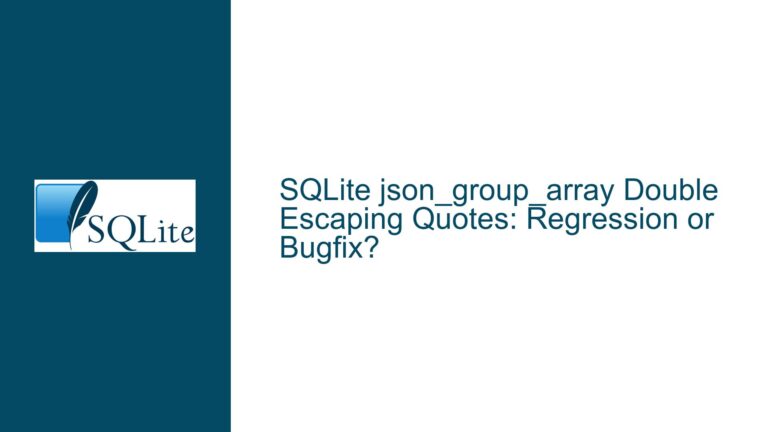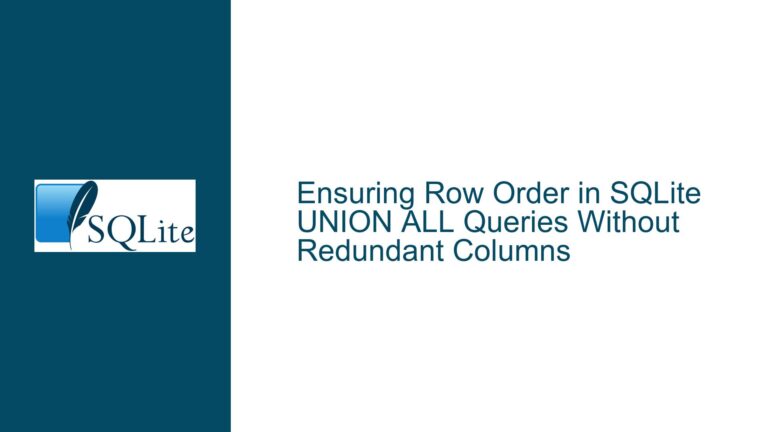FILTER Clause Incompatibility with SQLite Window Functions: Causes & Workarounds
Understanding FILTER Clause Restrictions on first_value() and last_value() in SQLite
The core issue revolves around the inability to use the FILTER clause with SQLite’s first_value() and last_value() window functions. These functions are classified as non-aggregate window functions in SQLite, which means they do not support the FILTER clause. This limitation becomes apparent when attempting to compute values based on conditional logic within a window frame. For example, a user may want to calculate the time difference between two timestamps by filtering rows where specific conditions (Client or QueueIndex columns) are met. While aggregate window functions like group_concat() work seamlessly with FILTER, non-aggregate window functions throw the error:
FILTER clause may only be used with aggregate window functions.
The distinction between aggregate and non-aggregate window functions is critical here. Aggregate window functions (e.g., sum(), avg(), group_concat()) process multiple rows within a window frame to produce a single result. Non-aggregate window functions (e.g., first_value(), last_value(), nth_value()) return a value from a specific row within the window frame. SQLite’s implementation adheres to the SQL standard, which restricts the FILTER clause to aggregate functions. This design choice ensures compatibility with other database systems like PostgreSQL, which enforce similar restrictions. However, it creates challenges for users who need to conditionally filter rows within a window frame before applying non-aggregate functions.
In the provided example, the user attempts to replace a group_concat()-based workaround with last_value() to simplify their query. The workaround uses group_concat(TStamp,'|') with a FILTER clause to concatenate timestamps, then extracts the last value using a custom csv() function. While functional, this approach is inefficient due to string manipulation overhead. The ideal solution would involve last_value(TStamp) with a FILTER clause to directly retrieve the desired timestamp without intermediate steps. However, SQLite’s current architecture prohibits this, necessitating alternative strategies.
Root Causes of FILTER Clause Incompatibility with Non-Aggregate Window Functions
1. SQL Standard Compliance
SQLite prioritizes adherence to the SQL standard, which specifies that the FILTER clause is valid only for aggregate functions. Non-aggregate window functions like first_value() and last_value() are excluded from this provision. This ensures cross-database compatibility but limits flexibility for advanced use cases. For instance, PostgreSQL also restricts FILTER to aggregate window functions, reinforcing the standard’s influence.
2. Architectural Limitations in Function Classification
SQLite categorizes window functions into two groups:
- Aggregate Window Functions: These can process multiple rows and support
FILTER. - Non-Aggregate Window Functions: These operate on individual rows within the window frame and do not support
FILTER.
The internal implementation of non-aggregate functions lacks the machinery to handle filtered subsets of rows. Aggregate functions, by contrast, are designed to iterate over rows and apply conditions dynamically. Adding FILTER support to non-aggregate functions would require significant changes to SQLite’s window function engine, including modifications to frame traversal logic and result computation.
3. Performance and Optimization Tradeoffs
Non-aggregate window functions like first_value() and last_value() are optimized for speed, often leveraging index-based access to retrieve values from the window frame. Introducing FILTER would complicate this optimization. For example, a FILTER clause could force the function to scan the entire frame to find matching rows, negating performance benefits. The user’s observation about scanning up to 500 rows highlights this concern: a filtered first_value() would need to scan until the first matching row, which might not align with existing optimizations.
4. Lack of Customization Hooks
Unlike aggregate functions, which can be extended via SQLite’s sqlite3_create_window_function() API, non-aggregate window functions are hard-coded. Users cannot override their behavior to add FILTER support without modifying SQLite’s source code. This rigidity contrasts with aggregate functions, where custom implementations can incorporate filtering logic.
Effective Workarounds and Custom Solutions for Filtered Window Function Queries
1. Leverage Aggregate Functions with Conditional Logic
Replace non-aggregate functions with aggregate counterparts that emulate the desired behavior. For example:
-- Emulate last_value(TStamp) with FILTER using group_concat()
last_value(
case when Client or QueueIndex then TStamp else null end
) over (rows between 500 preceding and 1 preceding)
This approach uses CASE to nullify irrelevant rows, allowing last_value() to ignore them. However, it does not terminate early upon finding a match, potentially scanning all 500 rows.
2. Custom Extension Functions via SQLite API
Develop a custom window function that combines first_value()/last_value() with filtering logic. Using SQLite’s C API:
#include <sqlite3ext.h>
SQLITE_EXTENSION_INIT1
static void last_value_filtered(
sqlite3_context *ctx,
int argc,
sqlite3_value **argv
) {
// Custom logic to iterate over window rows and apply filter
}
sqlite3_create_window_function(
db,
"last_value_filtered",
1,
SQLITE_UTF8,
NULL,
NULL,
last_value_filtered_step,
last_value_filtered_final,
NULL
);
This function can be invoked in SQL as:
last_value_filtered(TStamp) filter (where Client or QueueIndex) over (...)
3. Subquery-Based Filtering
Use a correlated subquery to manually filter rows:
select
Line,
TStamp - (
select TStamp
from Log l2
where l2.Line < l1.Line
and (l2.Client or l2.QueueIndex)
order by l2.Line desc
limit 1
) as Duration
from Log l1
where Sent;
This mimics last_value() with a filter but may suffer from performance issues on large datasets.
4. Window Function Combinators with Arrays
Use json_group_array() or extensions like array_agg() to collect values and extract the desired element:
select
Line,
json_extract(
json_group_array(
case when Client or QueueIndex then TStamp else null end
) over (rows between 500 preceding and 1 preceding),
'$[#-1]'
) as LastFilteredTimestamp
from Log;
This method serializes filtered values into a JSON array and extracts the last element.
5. Frame Specification Adjustments
Narrow the window frame to reduce unnecessary scans:
last_value(TStamp) over (
order by Line desc
rows between unbounded preceding and current row
exclude current row
)
By reversing the sort order and excluding the current row, the function retrieves the most recent valid value without a FILTER clause.
6. Hybrid Approaches with Common Table Expressions (CTEs)
Precompute filtered values in a CTE:
with FilteredLog as (
select *, TStamp as FilteredTStamp
from Log
where Client or QueueIndex
)
select
l.Line,
l.TStamp - f.FilteredTStamp as Duration
from Log l
left join FilteredLog f on f.Line = (
select max(Line)
from FilteredLog
where Line < l.Line
);
This isolates filtered rows upfront, simplifying the main query.
By understanding SQLite’s function classification system and leveraging creative workarounds, users can achieve filtered window function behavior without direct FILTER clause support. Future enhancements to SQLite may bridge this gap, but until then, these strategies offer robust alternatives.






